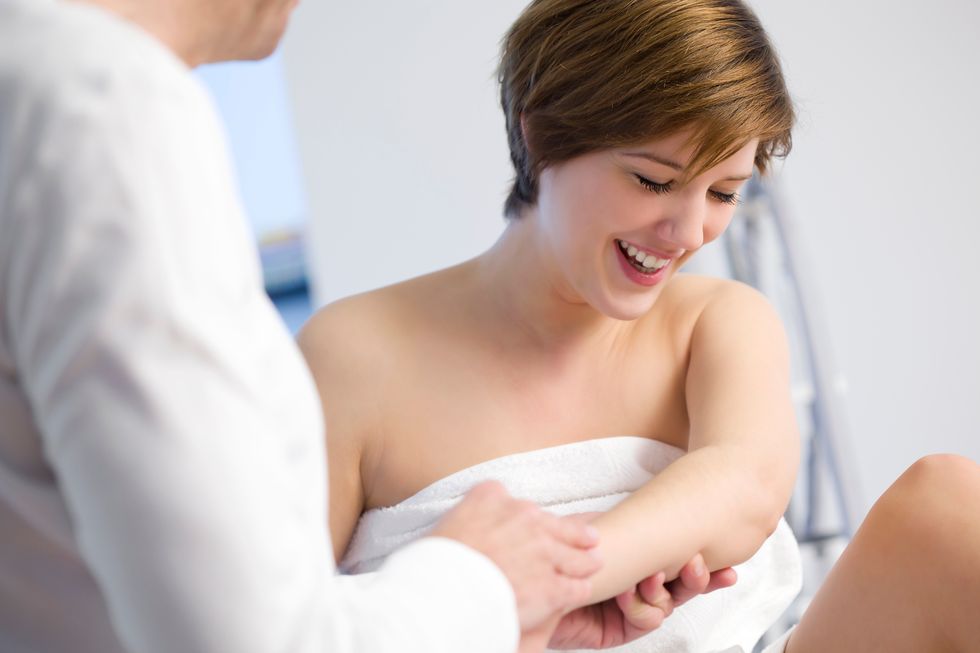
Diagnosis and Treatments for Bumpy Skin
Diagnosis and Treatments for Bumpy Skin
Bumps on your skin? It may be keratosis pilaris.
Apr 25, 2017
Jul 16, 2020
Lifestyle
Stacey Feintuch is a Blogger, Freelance Writer, Public Speaker and Young-ish Widow
Full BioLearn about our editorial policies

Ever heard of keratosis pilaris? Perhaps you know the more popular terms for this benign and annoying, yet common and harmless, condition—chicken skin or bumpy skin. These tiny, stubborn, rough bumps on skin are often on the backs of your arms. And attempts to scrub these bumps away are futile.
Keratosis pilaris happens when keratin—one of the skin's building blocks—is overproduced. That keratin plugs up hair follicles, causing tough, little bumps to pop up. The bumps are rough and reddish. While they're most often found on the backs of arms, you can also find this bumpy skin on your rear, cheeks and thighs.
Your health care provider or dermatologist will examine your skin, looking closely for signs of keratosis pilaris to make the diagnosis. (No testing is needed.)
People of all ages and races have the condition, which often begins before two years old or during the teenage years. It can continue into your adult years, but it often improves with age. You're more likely to get it if you have asthma, dry skin or eczema.
The condition is often genetic and unrelated to anything you may or may not be doing. And dry skin can make these bumps more noticeable. So, many people say the bumps disappear during the summer (full of moist and humid air) but reappear in the drier winter months.
Keratosis pilaris may not be curable, but it's controllable. You don't have to opt for a wait-and-see approach. Just remember that since keratosis pilaris is chronic, treatment is ongoing. Maintenance is the best way to keep your skin looking smooth.
Here are some measures you can take to help address your bumpy skin condition.
Eat Omega-3s
What you eat affects your skin's inflammation levels, including triggering or worsening your chicken skin. Consume a diet rich in omega-3 fatty acids—healthy polyunsaturated fats that can help boost heart health as well as promote healthy skin cell function and moisturization. Aim to consume salmon, tuna, soybeans, sardines, walnuts and flax seed.
Use Fragrance-Free Products
Keratosis pilaris can be caused or exacerbated by using fragrant body products like scented soaps and body washes, lotions, creams and perfume sprays. Aim to use products that are fragrance-free. To minimize dehydrating skin or removing oils from it, don't shower or bathe more than 10 minutes and use lukewarm, not hot, water. And avoid bar soaps that can be drying.
Rethink Hair Removal
Shaving or waxing skin with keratosis pilaris can cause more bumps to appear on your skin. Consider laser hair removal to remove the hair without causing flare-ups.
Avoid Self-Tanner
Applying self-tanner won't cover or hide the bumps. Rather, self-tanner use will make the bumps more obvious.
Get a Prescription for Retinoids
You may have used Retin-A to help deal with your acne. It can also help with your bumpy skin. Here, vitamin A increases cell turnover. That enables younger skin to come up faster so bumps flatten out. This treatment can take a few weeks to work its magic, so be patient. And a tiny dab of Retin-A can do wonders; otherwise, you'll be left with painful, dry skin. Speak with your health care provider or dermatologist about getting a Retin-A prescription.
Apply Healing Skin Care Products
Look for products with urea, glycerin and lactic acid to help treat and prevent your bumpy skin. These ingredients can help remove the scales that are causing the bumps to form. These over-the-counter and prescription products are typically gentle, so don't worry if you have sensitive skin. Because using such products can dry out the skin, apply an oil-free cream or ointment moisturizer after bathing or when your skin feels dry.
Gently Exfoliate
When you exfoliate, you're removing dead skin cells from the surface. That helps diminish the bumps and improve your skin's texture. You can exfoliate using a buff puff, rough washcloth or loofah. To avoid irritating the skin and worsening the condition, avoid scrubbing your skin.
Turn on a Humidifier
Low humidity dries out the skin, says the Mayo Clinic. Using a portable humidifier or attaching one to your furnace can add moisture to the air in your house.
Try Lasers
When moisturizers and medicines don't do the trick, you may turn to a laser or light treatment. One type of laser may reduce the swelling and redness. Another type of laser may improve your skin's texture and decrease discoloration, such as the brown spots that may appear when the bumps clear, says the American Academy of Dermatology.